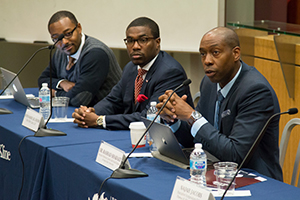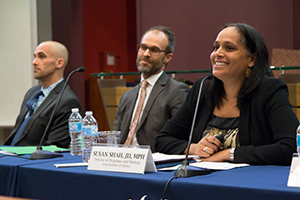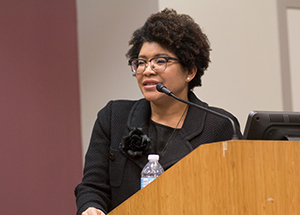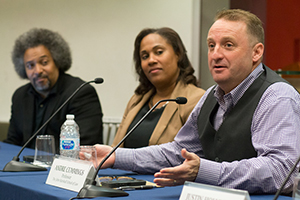From the days of slave patrols to 2017, race has played a predominant role in shaping police policy and conduct, scholars and practitioners said during a symposium sponsored by the Drexel Law Review on Oct. 17.
“Race & Policing: Defining the Problem and Developing Solutions” featured perspectives of legal scholars, former prosecutors and criminal defense attorneys on an enduring practice of basing criminality on skin color and substantial reforms that are needed to reverse injustice.
The daylong symposium started with remarks by Dean Daniel Filler, a former public defender who observed the power police hold to distribute the most vital commodity in society.
“The police have the capacity to distribute freedoms on a daily basis by the choices they make,” Filler said, adding that he is proud that Kline students chose to take on a topic “at the core of what we should talk about at the law school.”
 The first panel, featuring Professor Rashad Shabazz of Arizona State University, Kevin Harden, an attorney with Ross Feller Casey and a former prosecutor, and Howard University School of Law Professor Justin Hansford, set the stage by describing the dynamics in broad terms.
The first panel, featuring Professor Rashad Shabazz of Arizona State University, Kevin Harden, an attorney with Ross Feller Casey and a former prosecutor, and Howard University School of Law Professor Justin Hansford, set the stage by describing the dynamics in broad terms.
Shabazz discussed geographic, demographic and economic shifts creating, over decades, segregated communities in American cities that became ripe for aggressive policing. Meaningful solutions, Shabazz said, will only come from decriminalization, disarmament and creation of sustainable urban communities.
Harden argued that integrating the law enforcement community has not addressed underlying problems.
“Systems can become inherently racist through policy,” Harden said, calling for a response akin to surgery in place of chemotherapy. “We have to cut the cancer. Police force is a lethal level of treatment into our communities with the hope that they will survive.”
Hansford challenged the notion that the courts have vigorously upheld civil rights, noting that key U.S. Supreme Court rulings in the 1960s turned on technicalities rather than rights enshrined in the constitution. Hansford contrasted the placid behavior of police at the Unite the Right rally in Charlottesville, Virginia just months after hundreds of arrests were made during protests against the shooting of unarmed teen Michael Brown in Ferguson, Missouri.
A second panel with attorney Susan Shah of the Vera Institute of Justice, Professor Tryon Woods of the University of Massachusetts-Dartmouth and Professor Khalil  Saucier of Bucknell University linked current dynamics with their historic roots.
Saucier of Bucknell University linked current dynamics with their historic roots.
Noting the status of the U.S. as the world leader in incarceration, Shah said that poverty itself has driven criminalization, with individuals to be locked up for failing to pay child support. Police training is part of the problem, Shah said, adding that military tactics take the place of techniques that would de-escalate conflict.
Woods contrasted the 1900 ruling in John Bad Elk v. United States, in which the U.S. Supreme Court upheld an individual’s right to use force to resist an unlawful arrest, with the 2016 shooting of Randallstown, Maryland resident Korryn Gaines, whom police killed after storming her home to serve a warrant for a traffic stop.
“Black people are disqualified from self-defense,” Woods said.
Bucknell University Professor Khalil Saucier discussed breed-specific legislation against pit bulls as a “gateway to a form of punishment” in its ability to give police a new enforcement tool in urban communities.
 In the keynote, Professor and Associate Dean Tamara Lawson of the St. Thomas University School of Law explored the dearth of criminal charges and convictions in the face of police brutality.
In the keynote, Professor and Associate Dean Tamara Lawson of the St. Thomas University School of Law explored the dearth of criminal charges and convictions in the face of police brutality.
Professional athletes who’ve stirred controversy by “taking a knee” could be responding either to police misconduct or to inaction by prosecutors, said Lawson, who served as a deputy district attorney in Las Vegas, Nevada.
Payouts such as those made by U.S. cities in civil police misconduct cases that tallied some $1 billion from 2010 and 2014 fail to deliver justice, Lawson said, noting that taxpayers bear the financial burden for these wrongs and that the officers involved are shielded from punishment or other consequences.
Prosecutors with the will have the means to go after criminal conduct by police, Lawson said, noting that they have become much more aggressive in pursuing cases involving domestic violence, drunk driving and rape, from which they blanched in prior decades.
“We changed our level of consciousness,” Lawson said. “You don’t hear prosecutors say ‘We don’t do rape cases because they’re hard.’”
In the symposium’s third panel, John Marshall Law School Professor andré douglas pond cummings, Defenders Association of Philadelphia Chief Defender Keir Bradford-Grey and Kline School of Law Professor Donald Tibbs discussed ways to change the paradigm of race and policing.
Cummings said law enforcement training and hiring should be changed to alter the dynamics between those policed and those who police. Private and for-profit  prisons should be abolished, cummings said.
prisons should be abolished, cummings said.
While police label communities with a large population of African Americans as “high crime” neighborhoods, Bradford-Grey cited statistics that show the opposite. Of the 70 percent of stop-and-frisk searches, which occur in black neighborhoods, Bradford-Grey said, only 8.7 percent produce contraband. Notably, she added, 15.7 percent of the searches that occur in non-black neighborhoods are productive.
A Police Accountability Unit created by the Defender Association has been a “game changer,” she added, since it allows accurate data to replace erroneous assumptions about activity in heavily policed neighborhoods.
Tibbs said that the deaths of unarmed black men including Michael Brown, Tamir Rice, Akai Gurley, Sam DuBose, Trayvon Martin and Eric Garner “seem to be less a new phenomenon than a continuation of a brutal past.”
Yet, Tibbs noted, the U.S. Supreme Court’s ruling in Kingsley v. Hendrickson, establishing standards for the treatment of suspects held in pretrial detention, departed from the customary deference typically given to law enforcement officials.
The court’s 2015 ruling required an “objective standard” to be used to decide if excessive force had been used.
“In Kingsley, the Court was clear to remind prison officials that, even when incarcerated, ‘Black Lives Matter,’” Tibbs said. "Perhaps, in these multitude of cases where the police are acquitted or not held accountable for their actions, which fall into the grey area of them 'acting under color of law' while perhaps violating someone’s constitutional rights, the juries, prosecutors and judiciary should take a lesson from Kingsley."